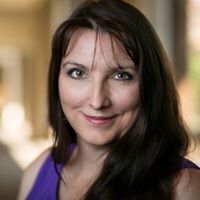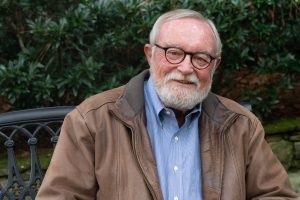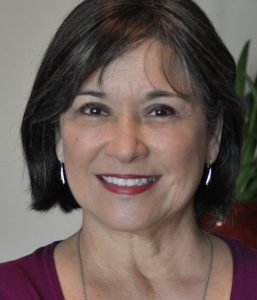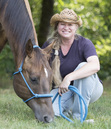Elena Hartwell's Blog, page 32
October 4, 2023
Dreams and Illusions: New Mystery Series
Dreams and Illusions, a Gabrielle Dorian Mystery by Rebecca Olmstead
Author Interview +Book & Author Info + Author Pet Corner!Don’t miss any author interviews. Click the link here.Dreams and Illusions
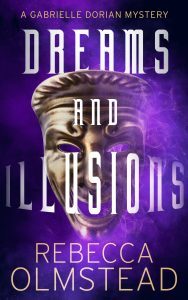
It’s 1999, but Gabrielle Dorian is not partying.
Gabrielle is a dreamer. Some call her a psychic, others clairvoyant. Her parents told her she had a gift from God, but why would God give her a gift that can’t save the people she loves most?
When a menacing masked figure begins to haunt her dreams, Gabrielle fears the worst is yet to come, and an urgent call from her estranged sister, Tina, confirms her fears. Determined to prevent God from taking the only family she has left, Gabrielle shelves her grief, leaving the comfort of her small hometown of Whitman, Washington for Seattle, where she finds Tina accused of first-degree murder.
Gabrielle hasn’t seen Tina in over ten years, and her sister’s animosity toward her hasn’t faded. The evidence is stacked against her, but Tina pleads her innocence. Unfortunately, Gabrielle has heard the same pleas before. But has Tina become capable of cold-blooded murder?
Taken aback when she finds Matthew Pierce heading the investigation, Gabrielle learns the wounds from their complicated history are still as fresh as they were ten years ago. Matt seems determined to drive Gabrielle back to Whitman and away from the case, but that only makes Gabrielle more determined to stay.
Tensions rise as Gabrielle digs deeper, uncovering secrets and lies. With no clue whom she can trust, Gabrielle must decipher her dreams and face old demons to uncover the truth, no matter how difficult that truth may be.
Dreams and Illusions is the riveting first book in the Gabrielle Dorian Mystery Series. If you like headstrong but wounded heroines, fast-paced drama, and dark twists, you’ll love Rebecca Olmstead’s tale of doubt and redemption.
Buy Dreams and Illusions to unmask a villain today!
To purchase Dreams and Illusions, click on the following link: AmazonInterview with Rebecca Olmstead Dreams and Illusions features Gabrielle Dorian. What should readers know about Gabrielle?Gabrielle is a warm, caring woman. Her gift of sight has made her somewhat of an outcast all her life, but that has made her especially empathetic to others.
It also makes her crave belonging. As a result, she is very protective of the few who are close to her. She was raised in the church but is having a crisis of faith.
This journey will take her up close and personal with God.
Dreams and Illusions takes place in Washington State, primarily Seattle. What drew you to that region for your novel?I wanted to take Gabrielle far out of her comfort zone for this journey. Not just emotionally, but physically.
She was raised in a small Washington town and only traveled with family. I needed to separate her from that to give her more room for growth and self-discovery.
Dreams and Illusions explores a complicated relationship between sisters. Tell us about the dynamic between Gabrielle and Tina:Gabrielle had been praying for a sister for some time when her parents adopted Tina. She had no knowledge of drug addicted babies, which is what Tina was. Tina was never capable of close personal attachments because of her mental disabilities. The more Gabrielle pursued a relationship with Tina, the more Tina pushed her away. Tina sees Gabrielle as the “perfect child, which causes resentment, while Gabrielle feels responsible for Tina and her “less-than-perfect” (read: criminal) behavior, because she prayed for a sister.
Gabrielle desperately wants a loving relationship with her sister but may have to learn to accept what Tina is able to give.
You write in multiple genres, does that process change from genre to genre? Or project to project? What’s a typical writing day like?I’m able to move from genre to genre by focusing on my characters.
Ideally, a writing day will begin after prayer, breakfast, and a walk or workout, which is when I’ll start thinking about the story I’m working on at the time. I’ll go to my studio, put on some smooth jazz, or whatever music fits the work, turn on my scent dispenser and start writing.
Working with my daughter makes this easier because we keep each other accountable. She also reminds me to eat when I’m on a roll. When I write first person POV stories, I get into the minds of my characters and just listen as they tell their stories.
In third person POV, I see the story play out like a movie from scene to scene, putting myself in the heads of each character. When I want to create a certain mood, I put myself into the story and describe a setting that makes me feel what I want the reader to feel.
Most days I’ll work until about five. If it’s going really well, I lose track of time until I hear my husband call, “I’m home!” Then I panic because I haven’t started dinner. 
We love to find waterfalls, so some of our favorite hiking trails are on the Historic Columbia River Highway Scenic Byway. But we will explore any trail to see where it leads.

At the moment, I’m working on a non-fiction book for teens and young adults. It’s called The Demon Slayers Handbook: How to Stop Being Satan’s B!#@h.
It was inspired by a dream that convinced me to empower kids to overcome the spirit of suicide. When that first draft is complete, I’ll be revising the second installment of the Gabrielle Dorian Mystery Series, Dreams and Deceptions.
Words of Wisdom for Aspiring Writers:Don’t worry about the market. Write the story you want to read and take every opportunity to learn to paint beautiful pictures and endearing characters. Then find the best editors you can.
Great advice!Author Pet Corner!
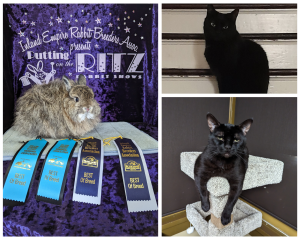
Our menagerie includes a crazy black lab, named Sophie, two black cats, Agatha and Ambrose, and 35 Jersey wooly show bunnies.
Luckily, our hundred-year-old Craftsman farmhouse was fathered in as farm property.
Rebecca Olmstead, Author of Dreams and Illusions
Rebecca Olmstead is an award-winning author of both fiction and non-fiction, speaker, and teacher. Her book, Loved So Much, It Hurts: Purpose in the Pain, is a Book Excellence Award and Global Book Award finalist.
Her short story, “The Uninvited Guest” is a fun read and her first award-winning story. She will be releasing Dreams and Illusions, the first in her Gabrielle Dorian Mystery Series in October, 2023, and her story, “Love and Snakes” will be in the Malice, Matrimony & Murder anthology in November.
Rebecca’s stories have been published in a number of periodicals, including Live, The Upper Room, Now What?, Focus on the Family’s Clubhouse, Jr., and Houseboat magazine.
When she’s not writing, Rebecca enjoys time with her family, camping, hiking, gardening, baking, and crochet. She also enjoys showing Jersey Woolies with her daughter.
To learn more about Rebecca, check out any of the following links: Website, Facebook, Instagram, Goodreads.Elena Taylor/Elena HartwellThe post Dreams and Illusions: New Mystery Series appeared first on The Mystery of Writing.
October 3, 2023
Incentive for Death: Debut Thriller
Incentive for Death, the debut thriller by James Spoonhour
Author Interview + Book and Author Info!Don’t miss any debut author interviews! Click the link here.Incentive for Death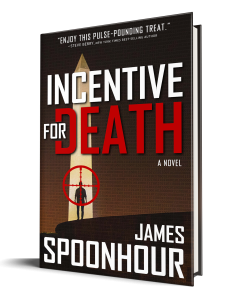 They all sold their life insurance policies to the same company— and now they’ re all dead. Mac and Oliver are on the case.
They all sold their life insurance policies to the same company— and now they’ re all dead. Mac and Oliver are on the case.
On a beautiful spring morning in Washington, D.C., a high-profile attorney is found dead in his office. McDermott “ Mac” Burke and Oliver Shaw, homicide investigators for the Metropolitan Police Department, are called to investigate. There appear to be no signs of foul play, but there is also no obvious sign of a natural cause of death.
The detectives are perplexed until the medical examiner notices a tiny pin prick on the lawyer’ s neck and theorizes that the man was injected with succinylcholine— aka “ sux” — which is a common horse tranquilizer that dissipates quickly in the body.
As Mac and Oliver begin to look further, they discover that the lawyer had sold his life insurance policy to a large viatical company. Then, they realize that more deaths under mysterious circumstances have occurred among those who’ ve sold their policies to the same company.
With mere coincidence seeming unlikely, Mac and Oliver dive headfirst into a now complex and far-reaching murder investigation— if they don’ t uncover what’ s really happening, many more lives could be at stake.
You can purchase Incentive for Death at the following retailers: Amazon, Barnes & Noble, Apple Books, Kobo.Interview with James Spoonhour, author of Incentive for DeathIncentive for Death is set in Washington DC, and features McDermott “Mac” Burke and Oliver Shaw, two Metropolitan Police Department homicide detectives. What should readers know about Mac and Oliver?McDermott “Mac” Burke is of Irish ancestry and grew up in Nebraska. Oliver Shaw is African-American and grew up in Washington, D.C.
Mac and Oliver became friends while both were serving as military investigators in Qatar. Mac was a Special Agent with the Air Force Office of Special Investigations, and Oliver was a Special Agent with the Army Criminal Investigation Division.
They each joined the D.C. police department following their military service and have been paired together as homicide detectives for 13 years. They successfully close nearly all of their homicide cases.
Mac still lives with his ex-wife, Maggie Hampton, three years after an amicable divorce. Unknown to Mac, his ex-wife is an operative for the CIA.
Incentive for Death takes place in an iconic city, why did you choose to set your debut novel in DC?I was a Special Agent with Air Force OSI and stationed in the Washington, D.C. area.
I also went to law school at Georgetown University in D.C. It is a truly unique city with tons of character and history. My goal is to make the city both background and a nonspeaking character in the book.
Tell us about your publishing journey with Incentive for Death:I have been an avid reader most of my life, consuming two to three books a week since I was 12. Over the past 20 years, I have scrutinized the books I was reading to analyze how the author developed the plot, built the characters and kept the pace moving. My long-held desire was to eventually write novels.
After retiring from practicing civil litigation and appellate law for four decades, I decided to finally pursue my dream of writing novels. I read about a dozen “how to” books and took online writing courses and seminars, as well as taking seminars taught by published authors.
I then outlined my first novel and started writing. The first draft was completed in four months, which was followed by a hard self-editing over the next five months. When I felt the manuscript was ready for submission, I researched literary agents and started submitting to ten or so agents at a time seeking representation. I focused on those agents who had a history of representing mystery authors.
After not succeeding in finding an agent through the direct submission route, I signed up for the 2021 ThrillerFest conference sponsored by International Thriller Writers and participated in all five days of the conference, including pitching my novel to agents. Those 3-minute pitches did not land me an agent.
I also signed up for 15-minute interviews with two particular agents and one publisher whom I had selected based on ITW video interviews of agents and publishers who had met with debut authors at the prior year’s conference.
The publisher with whom I scheduled an interview was Bob Gussin of Oceanview Publishing, which specializes in mysteries. Unfortunately, he was ill the day of our scheduled interview and we had to reschedule. He contacted me by email to reschedule our discussion about two weeks later. Since I now had his direct email, I sent him a summary of my book and the first 30 pages.
Our 15-minute call turned into 45 minutes and Bob Gussin asked me to submit a full manuscript, which I did that same day. Two months later, Oceanview contacted me to discuss my novel. I had an hour-long discussion with Pat and Bob Gussin, at the end of which they offered to buy Incentive for Death.
Fourteen months later, my novel hit the shelves on October 3, 2023.
You are a voracious reader! What have been some of your favorite books recently, and what did you love about them?Alma Katsu’s Red Widow and Red London. Alma was a panelist at the 2021 ThrillerFest, and I got a chance to talk with her one-on-one. She was a long-time CIA field operative and converted that experience directly into the lead character in these two novels. Great character development, good plotting and pace throughout both books.
S.A. Cosby’s All the Sinners Bleed. Cosby captures the latent and sometimes overt discrimination which exists in a small town on the Virginia shore of the Chesapeake Bay. He does a fantastic job of conveying how time may pass, but history doesn’t always move on. Great character development and pace. The locale becomes an active character in the tale.
James Polkinghorn’s Liquid Shades of Blue. A very successful debut novel. A partially defrocked lawyer buys a bar in Key West. Character development showing the conflict between son and father builds all the way through the story, while the son tries to unravel the deaths of his mother and brother. Solid plot and pace.
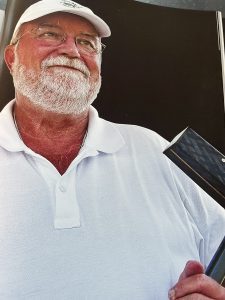 You are a serious croquet player! You even play in tournaments. What do you love about the game?
You are a serious croquet player! You even play in tournaments. What do you love about the game?Tournament croquet is not like the backyard croquet we grew up playing with our families. This is much more like chess and billiards on a lawn the size of a doubles tennis court.
The players wear all white clothing. The wickets are not wire hoops, but rather steel tubes planted deep in the ground which are barely wider that the balls that have to go through them. The game involves strategy that requires moving balls five shots ahead of one’s current stroke to keep moving around the greensward (court).
What are you working on now?Two things. First, I’m dealing with book signings and promotion of my first novel, Incentive for Death, through advertisements, postings and emails.
Second, I’m working on the next tale in the Mac Burke series, which has a working title of Prepare to Die. Even more deaths and action than the prior novel.
Words of Wisdom for Aspiring Writers:Study how the books that grab your attention are assembled. About 20 years ago I found myself analyzing how each particularly well written book was put together. Was the writing itself well crafted? Was the plot intricate enough to hold the reader’s attention? Were the characters well developed? After reading the last page, did you say to yourself that you had just finished a well written book?
Read good books on “how to write” novels or non-fiction. There are a lot of so-so ones. Ignore them. Some really good ones are Sol Stein’s On Writing and Stephen King’s book by the same title.
Don’t obsess about things like third person omniscient and the other drivel of that sort. Just write your story. Simple language conveys the story.
Author Pet CornerI’ve had four dogs over the years. First a terrier, then a miniature schnauzer, then a black standard poodle, and finally a bearded collie (who would climb on the back of the sofa and lick my bald spot).
After high school, I worked as a cowboy on my grandfather’s ranch in central Texas (Hill Country). My horse was a Bay mare with a contrarian mindset. We also used Australian sheepdogs.
James SpoonhourJim Spoonhour has been a compulsive reader since age 12, consuming two or three books per week his entire life. Like many addicted readers, he long aspired to write novels and has finally ventured into the world of putting stories on paper.
During the interim, Jim got two degrees from the University of Nebraska in Political Science. Then he served as a Special Agent in the Office of Special Investigations while in the Air Force. While assigned to the Pentagon on a major leak case, Jim started attending law school at Georgetown University at night.
After graduating from Georgetown, Jim practiced civil litigation and appellate law with a large law firm in Orlando, Florida for many years. He also was a law professor at the Loyola University School of Law in New Orleans.
Jim is a member of the following writers’ organizations: International Thriller Writers, Mystery Writers of America, Jericho Writers (Oxford, UK), Career Authors, and Debut Authors Program of the International Thriller Writers.
In addition to reading and writing, Jim’s other joy in life comes from playing tournament croquet over the past 30 years. He occasionally even wins a tournament here and there around the country. Jim is now dedicated to writing and has nearly completed the second in the Detective Mac Burke series.
To learn more about James, click on any of the following links: Website, Facebook, & LinkedInElena Taylor/Elena HartwellHeader Image by Wenhan Cheng from Pixabay
The post Incentive for Death: Debut Thriller appeared first on The Mystery of Writing.
September 29, 2023
Landslide: Debut Thriller
Landslide, the debut thriller by Adam Sikes
Author Interview + Book and Author Info!Don’t miss any debut author interviews! Click the link here.Landslide International Arms—Private Military Companies—Corruption at Every Turn
International Arms—Private Military Companies—Corruption at Every Turn
U.S. Marine veteran Mason Hackett moved to London to start his life over, and he’s done his best to convince himself that what happened fifteen years ago doesn’t matter—the people he killed, the men he lost, the lives he ruined. But when Mason sees the face of a dead friend flash on a television screen and then receives a mysterious email referencing a CIA operation gone bad, he can no longer ignore his inner demons.
Driven by loyalty and a need to uncover the truth, Mason launches on a perilous journey from the Czech Republic to Romania toward the war-torn separatist region in eastern Ukraine to honor a fifteen-year-old promise. The answers he seeks—the fate of a friend and his connection to the underworld of international arms dealers and defense corporations—throw Mason into the cauldron of a covert war where no one can be trusted.
To purchase Landslide, click any of the following links: Amazon, Barnes & Noble, BooksAMillion, IndieBound, Kobo, Apple Books, Google Books.Interview with Adam Sikes, author of Landslide Landslide, your debut thriller, starts in London, and travels to the Czech Republic and Romania. What drew you to the international settings?I love traveling, I love being overseas, and I love books with international settings. I enjoy reading books set in NYC or the Rockies or a small town in Maine, but if you were to look at my bookshelf in my house, most books take place in foreign countries.
Coupled with the fact that I spent over half of my time with the military and with CIA living and working overseas, and have considered living abroad again, I think crafting an international spy thriller made perfect sense.
What should readers know about Mason Hackett, main character of Landslide ?Mason Hackett is not perfect and he makes mistakes, just like real people, and I developed him intentionally to be like that. I’ve had the pleasure of serving alongside some of this nation’s top special operators and intelligence officers, and everyone makes mistakes, acts with minimal information, and sometimes chooses the wrong direction … it may not happen often, but it does. Therefore, I wanted Mason to reflect this reality.
In my opinion, what makes a person the best is not that they do everything perfectly; it’s how they react and bounce back from mistakes and adversity. They know how to adapt and shift and make things happen—to win, even if it’s ugly. So, when you read Landslide and watch Mason make mistakes and or react in the moment, it’s because that’s what we do when faced with uncertainty, particularly in high-stress situations.
Tell us about your road to publication with Landslide :Although Landslide is my debut novel, it’s not my first manuscript.
The first novel I wrote took me two years and I learned a tremendous amount—but thankfully, that novel will never be published (at least how it was originally written). Looking at it now, that book was atrocious LOL.
Nevertheless, I took what I learned, used the contacts I had made, and wrote another novel. I did much better this go around, I think, and that manuscript landed me my agent. But that book didn’t get picked up for publication, either.
That’s when I started writing Landslide, and my agent really pushed me to write the things I’d been holding back—to tap into the hard and uncomfortable experiences I had as a US Marine and then as a CIA paramilitary officer. Working through that—drilling into the emotions and the feelings and the thoughts I knew about firsthand—gave Landslide the texture it now has. And I believe that’s why it got picked up by Oceanview Publishing.
From when I started writing my first book to Landslide coming out, it was a seven-year journey for me. And even with all the rejection and criticism (sometimes constructive, sometimes not), I loved every minute of it. Writing is what I think about falling asleep and what I wake up looking forward to every day.
How does your experience working for the CIA and the US Marines impact your writing?I rely on my experiences with CIA and in the Marines immensely, but I also have to be cautious in what I write about.
I spent over twenty-five years in national security, both in uniform and then as a paramilitary officer doing covert action. I started in the mid-1990s with the Bosnian conflict, and over the years served in Afghanistan, Iraq, elsewhere in the Middle East, East Africa, Europe and Eastern Europe, and Russia. I’ve been in numerous wars and conflict zones, and I’ve worked in the back alleys as well as the high-end locales of major cities conducting intelligence operations.
Consequently, I have an immense amount of experiences to draw upon and have met all kinds of fascinating people to inform my characters.
Yet, everything I write must undergo a formal review by CIA to ensure I haven’t disclosed any classified information or written about something sensitive pertaining to current operations. Therefore, I am very careful to make sure my stories are fictional and products of my imagination, while also trying to impart that realism and credibility readers crave.
Even though my novels are inspired by true events and real people, I’ve changed them enough to ensure I still adhere to my oath to properly handle classified information and protect the men, women, and operations that are still ongoing.
What are you working on now?My next novel, The Underhanded, comes out in April 2024, so I am working diligently to promote the book and prepare for the launch. But I am also writing the sequel to Landslide, as well as preparing for my next project. I always have ideas percolating, and one day, I hope I have enough time to work on them all.
Words of Wisdom for Aspiring Writers:If you’re serious about being a writer, treat it like a job, because it is. You might not be getting paid yet, you might not have an agent or a publisher yet, but you need to approach writing as if you are. Protect your time to write, read as much as you can (that’s part of being a writer, too—reading), be open to criticism, and write, write, write—every day.
Great Advice!Adam Sikes, Author of Landslide Adam Sikes is a novelist and non-fiction author, and his debut thriller, Landslide, was a finalist for the National Indi Excellence Awards.
Adam Sikes is a novelist and non-fiction author, and his debut thriller, Landslide, was a finalist for the National Indi Excellence Awards.
His forthcoming novel, The Underhanded, is set for release in April 2024. He also co-authored Open Skies: My Life as Afghanistan’s First Female Pilot.
Prior to taking up the pen, Adam served for over twenty-five years in US national security and is a former paramilitary officer with the CIA and a US Marine Corps combat veteran. He has lived and operated in the Middle East, Central Asia, Africa, Europe, and Russia.
Wherever he went, his books and notepads came with him, and his experiences now inform his writing. Adam holds an M.A. in History from Georgetown University and resides in Southern California.
To learn more about Adam, follow him at the following links: Website, Instagram, Twitter, Goodreads, BookBub, Facebook.Elena Taylor/Elena HartwellHeader image by PIRO from PixabayThe post Landslide: Debut Thriller appeared first on The Mystery of Writing.
September 27, 2023
Death and the Sisters: Historical Mystery
Death and the Sisters, a new historical mystery by Heather Redmond
Author Guest Post + Book and Author InfoDeath and the Sisters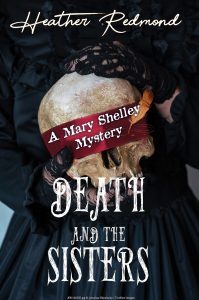 The tangled relationships between Frankenstein author Mary Shelley, poet Percy Bysshe Shelley, and Mary’s stepsister Jane Clairmont form the backdrop for an intriguing historical mystery, set in London in 1814, that explores the complex dynamic between sisters and the birth of teenaged Mary’s creative genius.
The tangled relationships between Frankenstein author Mary Shelley, poet Percy Bysshe Shelley, and Mary’s stepsister Jane Clairmont form the backdrop for an intriguing historical mystery, set in London in 1814, that explores the complex dynamic between sisters and the birth of teenaged Mary’s creative genius.
London, 1814: Mary Godwin and her stepsister Jane Clairmont, both sixteen, possess quick minds bolstered by an unconventional upbringing, and have little regard for the rules that other young ladies follow. Mary, whose mother famously advocated for women’s rights, rejects the two paths that seem open to her—that of an assistant in her father’s bookshop, or an ordinary wife. Though quieter and more reserved than the boisterous Jane, Mary’s imagination is keen, and she longs for real-world adventures.
One evening, an opportunity arrives in the form of a dinner guest, Percy Bysshe Shelley. At twenty-one, Shelley is already a renowned poet and radical. Mary finds their visitor handsome and compelling, but it is later that evening, after the party has broken up, that events take a truly intriguing turn. When Mary comes downstairs in search of a book, she finds instead a man face down on the floor—with a knife in his back.
The dead man, it seems, was a former classmate of Shelley’s, and had lately become a personal and professional rival. What was he doing in the Godwins’ home? Mary, Jane, and Shelley are all drawn to learn the truth behind the tragedy, especially as each discovery seems to hint at a tangled web that includes many in Shelley’s closest circle. But as the attraction between Mary and the married poet intensifies, it sparks a rivalry between the sisters, even as it kindles the creative fire within . . .
Genre: Historical mystery
Published by: Kensington
Publication Date: September 2023
Number of Pages: 320
ISBN: 9781496737991 (ISBN10: 1496737997)
Series: Mary Shelley Mystery, 1
To purchase Death and the Sisters, click any of the following links: Amazon | Barnes & Noble | BookShop.org | Goodreads | Kensington
Mary Shelley and her stepsister, Jane Clairmont, are the main characters of my new mystery series, which kicks off with Death and the Sisters. I’ve discovered that most people know little about the author of Frankenstein, but she lived a fascinating life with a family just as interesting as her.
Born in 1797, Mary’s birth cost her mother, feminist philosopher and novelist Mary Wollstonecraft, her life. Mary’s father was anarchist philosopher and novelist William Godwin. William and Mary, just thirty-eight, had only been married for eight months before childbed fever took her eleven days after her baby was born.
While these weren’t people who particularly believed in marriage, they recognized the constructs of the society they lived in as they left their youths behind. They had married in order to make their unborn child legitimate. Wollstonecraft already had an illegitimate daughter, Fanny. 3 ¼ years older than Mary.
William, already over forty, immediately tried to find another wife, but was unsuccessful until Mary was four. He then married his next-door neighbor, French translator Mary Jane, who had two illegitimate children, Charles and Jane Clairmont, who were half siblings. This marriage led to five children being raised in the same household, none of whom were full siblings.
As they attempted to make their precarious living, they moved to a run-down house with no rent payment, in a neighborhood of prisons. Mary missed her old neighborhood, and all of them suffered health issues. Everyone traveled in the family for periods of time, to get away from London.
Resources were scarce, and this created a life-long rivalry between Mary and Jane. Jane and Charles had more money spent on them than Fanny and Mary. Jane had more education and music lessons. Charles was educated expensively in the book business. Fanny had an interest in education, but spent her time running the house and waiting on her stepfather. Mary and Jane seemed to have a future as shopgirls for the family bookshop. In that era, nothing better could be hoped for, when women could only be wives, teachers, governesses, or companions. The girls were not raised to want material things or marriage.
The Godwins were in a great deal of debt and lived outside of their means. One key tenant of Godwinian philosophy was that it was fine to accept money from others if you had none, which led to him demanding and begging for money. It later led to scandal, as it was rumored that he had sold Mary and Jane to nobleman Percy Bysshe Shelley for money to pay his never-ending debts. The optics were terrible, to be sure, after the events of summer 1814 when Mary and Jane ran away to France with the married man.
That spring though, beautiful Mary was closing in on her seventeenth birthday. She’d already had two suitors before Percy Bysshe Shelley entered her life. Jane, less mature and used to getting her way, simply wanted attention, and Percy treated her like a little sister. Both wanted his time. He seemed to offer it equally.
When Mary finds the body of a young man in their bookshop one night, she thinks Shelley has been killed. When Jane joins her and they realize Shelley isn’t dead, Jane thinks Shelley probably killed the youth, while Mary staunchly believes in his innocence. This difference in opinion impacts their ability to solve the murder, which has damaged the reputation of their family even further.
Mary has found the person she wants to spend time with. Shelley’s marriage doesn’t matter to her. She knows he is estranged with his wife, or at least thinks she knows it. Jane, having lost Mary’s attention, attempts to find a new friend, but she’s also holding onto a few secrets of her own.
Both wanting to escape each other, the reality is that they are hopelessly intertwined. They even battle over their roles as heir to Mary Wollstonecraft, Mary’s mother, who neither of them really knew. Jane considers herself the spiritual heir to Wollstonecraft’s life and philosophy, if not a biological one. She’s the true free spirit, whereas Mary is more conventional.
The fight with Jane for resources from family, lovers, and friends will continue for the rest of Mary’s life. It puts them both in danger as the choices they make attract the attention of a murderer.
I use the contrasting points of view of both girls to drive my novel. Welcome to the amazing world of anarchist poets and novelists in Regency England.
Heather Redmond, Author of Death and the Sisters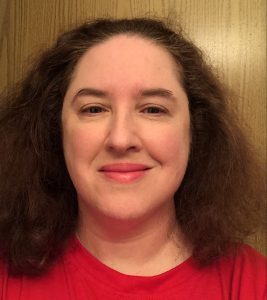 Heather Redmond is an author of commercial fiction and also writes as Heather Hiestand. First published in mystery, she took a long detour through romance before returning. Though her last British ancestor departed London in the 1920s, she is a committed anglophile, Dickens devotee, and lover of all things nineteenth century.
Heather Redmond is an author of commercial fiction and also writes as Heather Hiestand. First published in mystery, she took a long detour through romance before returning. Though her last British ancestor departed London in the 1920s, she is a committed anglophile, Dickens devotee, and lover of all things nineteenth century.
She has lived in Illinois, California, and Texas, and now resides in a small town in Washington State with her husband and son. The author of many novels, novellas, and short stories, she has achieved best-seller status at Amazon, Barnes and Noble, and other retailers. Her 2018 Heather Redmond debut, A Tale of Two Murders, has received a coveted starred review from Kirkus Reviews.
To learn more about Heather, click on any of the following links: www.HeatherRedmond.com, Goodreads, BookBub – @heatherredmond1, Instagram – @hiestandheather, Twitter – @heatheraredmond & Heather Hiestand Redmond’s Reader Group on FacebookVisit all the Stops on the Tour!
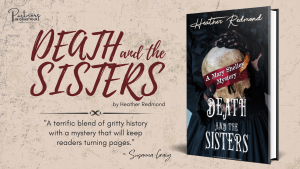
The post Death and the Sisters: Historical Mystery appeared first on The Mystery of Writing.
September 26, 2023
The Human Trial: A Medical Thriller
The Human Trial, a medical thriller by Audrey Gale
Author Interview + Excerpt +Book & Author Info + Author Pet Corner!
Don’t miss any author interviews. Click the link here.
The Human Trial
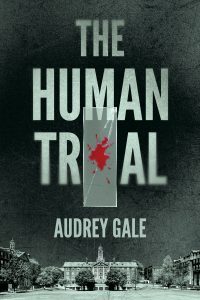 LOS ANGELES – In her latest work, “The Human Trial” (Books Fluent, Sept. 26, 2023), author Audrey Gale merges three genres: historical fiction, medical thriller and coming-of-age story, cast with imperfect, relatable characters.
LOS ANGELES – In her latest work, “The Human Trial” (Books Fluent, Sept. 26, 2023), author Audrey Gale merges three genres: historical fiction, medical thriller and coming-of-age story, cast with imperfect, relatable characters.
After an agonizing climb to earn his pathology specialty from Harvard Medical, early discoveries in the microscopic realms threaten not only Dr. Randall Archer’s hard-won place in the field of medicine, but his very life. Dr. Randall Archer has always been a misfit… …in the brutal blue-collar home where he grew up …as a 16-year-old escaping to college, then medical school, on a full scholarship to Harvard. …in the highest echelons of Boston society, where the woman he marries and the blueblood research partner with whom he shares his laboratory belong Even Archer’s brilliance as a pathologist catapults him into direct and dangerous conflict with the medical establishment he fought so hard to join.
As the Great Depression presses down around him, Archer teeters at the edge of a precipice. He must choose between his hard-won career and the sacred oaths he took as a doctor and scientist—before all his choices are lost forever.
Audrey Gale | Sept. 26. 2023 | Books Fluent
Historical Medical Thriller / Suspense / Murder Mystery
Paperback | ISBN: 978-1-953865-70-0 | $16.99
Ebook | ISBN: 978-1-953865-71-7 | $7.99
Audiobook | ISBN: 978-1-953865-72-4 | Price TBD
To purchase The Human Trial click on any of the following links: Amazon, Barnes & Noble.
Read an excerpt:
The Human Trial
Randy Archer skulked low in his seat in the overcrowded classroom, hanging his head so his black tangles concealed the angry lump on his forehead. If the bullies who enjoyed making his life a living hell caught sight of it, they’d be on him like ravenous dogs on the scent of fresh blood. Ignoring the teacher, Archer focused on hiding all signs of vulnerability. But the pretty blonde seated beside him who headed the baton twirling squad—Julie, Julia?—was struggling with the science review conducted from the front of the classroom. She mumbled her confusion under her breath. “The smallest solid particle in the universe is a-a what?”
As if he’d heard every word, Mr. Ehn singled her out. “Miss Julie,” he began, grinning as he paced through the rows of students, “there’s been quite a bit of upheaval in the scientific world of late. Recount for the class what we’ve been learning about the dramatic new hypotheses advanced by physicist Niels Bohr and others. Please stand.”
“Um,” she hedged, coming to her feet slowly as Mr. Ehn drew closer. Taking pity on her, Archer slid a note over for her to read. “Yes, Mr. Ehn,” she stalled, “yes, well, we’ve been studying, a-a new understanding . . . of the atom!” The last word gushed out with her relief as she plopped back onto her seat, mouthing a too-obvious thank-you to her seatmate.
Archer winced, knowing what was to come. On cue, the teacher called his name. “Randy Archer, you generally have a depth of knowledge that on occasion seems to elude your classmates.” That grin again as Mr. Ehn’s eyes, weirdly magnified behind thick lenses, swept the room before coming to rest on Archer. “Describe for all of us the evolution of our understanding of the miniscule atom.”
Archer could easily recite that evolution from the very beginning when the Greek Democritus invented the name centuries BC. What else could I do to avoid my family but spend long hours in the library studying? He rose carefully, moving nary a hair on his head.
For a moment, Archer considered minimizing the resentment his brain power often inspired. But, in the end, just like at home, he couldn’t hold back exhibiting his one superior trait. Father, brothers, and bullies be damned. “I believe, Mr. Ehn, you are referencing the atom, considered for centuries as ‘the basic building block of nature.’ In other words, the smallest, invisible, and indivisible solid unit in all of nature. However, in the two and-a-half decades since Thomson, in 1897, discovered particles within the atom, the first being the electron—”
“Thank you, thank you, Mr. Archer, that will do. Leave some of these sensational discoveries for your fellow fledgling scientists here to expound upon.” The instructor perused the class room for his next victim, enjoying the squirming it evoked. “Mr. McGrevey, would you care to elaborate on—”
The bell signaling the end of class clanged loudly, interrupting Mr. Ehn’s inquisition. Varsity linebacker Jimmie McGrevey, Julie’s boyfriend, led the class in clambering for the exit while Archer hung back—hoping, like any battered pugilist, that the bell would save him.
But the moment he entered the hallway, overflowing with students bantering during the short break between classes, trouble awaited.
*** Excerpt from The Human Trial by Audrey Gale. Copyright 2023 by Audrey Gale. Reproduced with permission from Audrey Gale. All rights reserved.
Interview with Audrey Gale
Before we dive into everything else, tell us about the main characters we meet in “The Human Trial.”
First is the pathologist, Dr. Randall Archer, with whom the story opens. He’s from a brutal blue collar home, which he escapes at the age of 16 by winning a scholarship to Harvard, which carries him through medical school to a pathology specialty. Archer, standing out for all the wrong reasons at Harvard, nevertheless collaborates with a blueblood physicist developing a breakthrough microscope. It offers, Archer anticipates, many advantages over others at the medical school. It also leads to Archer meeting another blueblood whom, despite its unlikeliness, he marries.
HIs collaborator is Dr. Adam Wakefield, PhD Physics, whose breakout microscope changes everything for the two men, not just in what they are able to observe, but in the increasing risk they face as, inadvertently, their findings challenge the very basis of western medical theory and practice.
Finally, Elizabeth Perrish, the sole daughter to the Brahmin Perrishes who traced their history in Boston back to its founding, is a woman ahead of her times, determined to do more than her high social ranking expects of her. Her budding relationship with Archer is the final straw which causes her to be cast from her family, penniless but undaunted, during the worsening Depression.
Are Dr. Randall Archer and Dr. Adam Wakefield based on real people?
While the two characters are inspired by real life scientists, they are a figment of my imagination. I focused more on their discoveries, which likely cost them both their lives, than on portraying the men and their actual existences with accuracy.
How did you come up with the concept of this novel?
Soon after I arrived in Los Angeles, my Golden Retriever became quite ill. I was advised multiple times to “put her down,” as 13 was a very respectable age for a big dog. But I couldn’t without turning over every stone first. I found a holistic vet who at our first meeting appeared to be practicing magic, for lack of understanding. Luckily he was very forthcoming about his medical treatments and the men upon whom they had been based.
But it was subsequently, when my dad, diagnosed with leukemia and refusing a second chemo treatment, agreed to visit my vet with me that I became hooked. The vet created a tape of sound vibrations that related through stepped-down octaves to the rate of vibration of the microbes of leukemia. It sounds like mumbo-jumbo, I know, but upon a routine follow-up with his medical doctors, they declared his case to be the “damnedest case of spontaneous remission they had ever witnessed!” My father did not die of leukemia, but years later, of pneumonia.
Tell us about your research process. Did you consult scientists and healing practitioners?
To start with, I mined information from my vet. His knowledge was sketchy about the scientists but more solid on the underlying science. After studying their efforts, I then read everything I could on physics and quantum physics, medical practice and the field, and the growing movement looking into the energetic basis of existence. For example, I own a large text called, “The Rife Handbook” by Nenah Sylver, PhD, which lists diseases and the innate frequencies of their microbial life to be used in combating them. I attended a conference on the subject where lay people like me as well as PhDs and MDs gathered to share information. I purchased a frequency generating device for home use. Finally, I worked directly with a noted physicist and pathologist who helped me put their knowledge into plain English.
You write about complex medical issues and scientific concepts in your novel – how did you go about making this subject digestible and accessible to readers?
This was by far the greatest challenge of “The Human Trial.” Specialists have exclusive language, or jargon, often Latin- or Greek-based, which makes simplifying concepts into understandable English very difficult. But with their patience and my persistence and feedback from early readers, I think we got there. You be the judge. As my goal was to have a broad range of people begin to demand new and better medical treatment, it was also essential to utilize good storytelling techniques. Thus flawed characters, a difficult time in world history during the 1930s, a love triangle, suspense, twists were essential.
Some of your characters aren’t exactly likable, yet they’re still relatable. How did you strike that balance?
A flippant answer to that point is: Like life! That is where I began, with flawed characters, much like us, then adding often unbearable pressures, to endure or not endure. That makes them relatable. I hope readers ask, what would I do in that situation? Would I be as brave or duplicitous? How would I rationalize my choices? Since we can all relate to difficult situations, even when one does not approve of a character’s choices or doesn’t like him per se, sympathy is evoked by the predicament. It’s a phrase I quite hate, but largely, “we’re all doing the best we can.”
What role do class stratification and sexism play in your novel? Why was it important to you to address those issues in your writing?
Issues of class aren’t of major importance to me, rightly or wrongly believing one can do what one set her mind to. Someone’s wealth or station has rarely intimidated me. But a short stint on Harvard’s campus did impress upon me class distinctions.
But sexism, now that’s another story! Raised with four sisters, no brothers, in a traditional home with a stay-at-home mom and bacon-bearing dad, the real world shocked me as its double standards revealed themselves. An essential part of me needs to probe sexual equality and unrecognized biases, and will undoubtedly appear in some form in all my writing.
How did your personal experiences when your father was diagnosed with leukemia bring you to recognize the shortcomings of traditional medicine? Why was it important for you to address these issues in your book?
The universe either cursed or blessed me with direct exposures to the type of energetic or energy-based healing explored in my novel. And with that, I could simply not walk away from non-invasive approaches to healing which are quick, cheap, effective, with no debilitating or life-shortening side effects, and offered more than just life extensions of months or years, but apparent cures.
It goes back to my arrival in Los Angeles with a very sick dog who many vets said to put down. Since I couldn’t without turning over every stone, I found a holistic vet who seemed to perform miracles and was forthcoming about his treatments and on whom they were based. He gave my Golden Retriever three more years to the remarkable age of 16.
But then my dad’s turnaround with leukemia. He’d refused a second chemotherapy and agreed, when I boldly offered, to visit my vet with me. Doing little more than listening to sound frequencies related to his disease-microbes’s innate vibration rates, he appeared quickly “cured.” Upon returning to his medical doctors for a routine follow-up, they proclaimed his state as “the damnedest case of spontaneous remission they’d ever seen.” He would die years later of pneumonia.
What do you hope readers will take away from your novel?
My hope for “The Human Trial” is that minds will be opened to new possibilities which have been successfully blocked for almost a century. Assuming the discoverers had what they’d tested and believed they had, millions of people have died unnecessarily in that time. I hope readers will realize that they must be their own demanding advocates within our healthcare system. We must all ask questions, demand answers and proof, read everything, talk to everyone, compare responses.
Most of all I hope that someone in the position to carry forward this science will pick up the mantle and bring its benefits to all of life.
Without giving too much away, can you give us a sneak peek at what you have planned for the rest of the series?
I’ve extensively fleshed out the second installment in the trilogy that commences with “The Human Trial.” In it, the suppression of the science and fate of the scientists carries into the 1970s, another troubled time in our history. Student activism had carried over from black power to anti-war to feminism. Everyone had a cause which often gave participants license to demonstrate, sit-in, walk-out, protest, and in a few cases, riot. The Vietnam War was coming to a humiliating ending, and Nixon was about to leave the White House, unceremoniously.
Against that backdrop, the next generation of Archers and Wakefields find themselves caught up in dangerous circumstances which first, they struggle to comprehend and then, struggle to survive.
Finally, as we ourselves struggled to cope with Covid-19, its unprecedented deaths and shutdowns, it hit me: since the science of these stories deals directly with viral disease, a current day story makes more than perfect sense. It makes it necessary. All of these multigenerational continuations also emphasize the long and successful suppression of life-saving discoveries and their enormous costs in human life, both globally and down to the very personal lives of the next generation to be caught up in it.
Author Pet Corner!
 Madison and McKinley!
Madison and McKinley!Here are our two darlings. Madison Wisconsin Johnson, the Lab, came by plane from San Antonio. From hunting lineage, she was a handful. McKinley, our Golden Retriever, was ‘rescued’ from a puppy factory. She lived her first five years in an indoor/outdoor cage until her last litter required a Cesarean and rendered her no longer useful to the factory owners. She was a mess when we got her, but her girlish figure returned almost instantly with lots of hiking and playing. She’s still quite gun-shy with people but loves all other four-legged types, including our cats, who have since departed.
Both girls are now nine years old but don’t show any age at all due to their active lifestyle. They’re best friends, except on occasion when there’s a ball in play. They have been known to try to squeeze me off of my bed when I’m sleeping. If nothing better is happening, like someone with food or the potential of a run, they will sit beneath my desk and offer inspiration as I write. We’re so lucky!
Audrey Gale, Author of The Human Trial
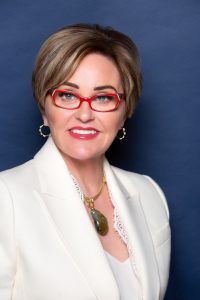 Audrey Gale long dreamed of being a writer, but never anticipated the circuitous road she’d take to get there. After twenty-plus years in the banking industry, she grew tired of corporate gamesmanship and pursued her master’s in fiction writing at the University of Southern California.
Audrey Gale long dreamed of being a writer, but never anticipated the circuitous road she’d take to get there. After twenty-plus years in the banking industry, she grew tired of corporate gamesmanship and pursued her master’s in fiction writing at the University of Southern California.
Her first novel, a legal thriller entitled The Sausage Maker’s Daughters, was published under the name A.G.S. Johnson. The novel explores one woman’s struggle to find her place amidst the upheaval of the radical 1960s.
Her second, The Human Trial, is the first book in a medical-thriller trilogy inspired by Gale’s own experiences with the gap between traditional medicine and approaches based on the findings of the great physicists of the 20th Century, like Einstein and Bohr.
Both The Sausage Maker’s Daughters and The Human Trial incorporate Gale’s fascination with historical and scientific research, and always with women finding their places. Gale lives in Los Angeles with her husband and dogs where she is found hiking the Santa Monica Mountains every chance she gets.
To learn out more about Audrey, click on her name or photo or follow her on the following sites: Facebook, Instagram.
Elena Taylor/Elena Hartwell
Header Image by Walter Frehner from Pixabay
The post The Human Trial: A Medical Thriller appeared first on The Mystery of Writing.
September 25, 2023
Parallel Secrets: Debut Mystery
Parallel Secrets: the debut mystery by ML Barrs
Author Interview + Book and Author Info + Author Pet Corner!Don’t miss any debut author interviews! Click the link here.Parallel Secrets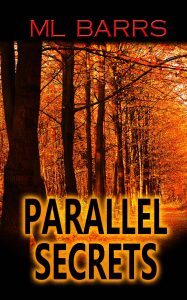 After a young girl goes missing, former TV crime reporter Vicky Robeson joins the search with the help of her attractive new love interest.
After a young girl goes missing, former TV crime reporter Vicky Robeson joins the search with the help of her attractive new love interest.
They take his RV to a tiny town in rural Missouri that’s filled with odd characters and darker secrets.
But Vicky has secrets of her own. She believes this kidnapped girl may be linked to a case she reported on nine years ago, when a mystery child was found walking on levee, bloody and unable to speak. Back then, Vicky failed to follow up clues only she knew. Now, she has a chance to redeem herself.
As she uncovers secrets, it becomes clear someone will kill to keep them hidden.
To purchase Parallel Secrets click the following links: Amazon, Barnes & Noble.Interview with ML Barrs, author of Parallel Secrets Parallel Secrets features TV journalist Vicky Robeson. What would you like readers to know about Vicky?Vicky is a sassy, tough, but inwardly tormented television journalist.
She was traumatized at an early age and has never fully dealt with her guilt stemming from that experience. She has trouble with personal relationships, though she cares about people. When she’s working on a story she is tenacious. She’s great at getting people to reveal their secrets but holds tight to her own.
Parallel Secrets takes place in the small town of Walkers Corner. Tell us about that community:Walkers Corner is a fictional township in rural Missouri, the kind of place where everyone seems to have dark secrets.
It’s populated by odd characters, including those Vicky mentally dubs Mysterious Swamp Dude, Minnesota Man, and Suspicious Neighbor. It is located somewhere between St. Louis and Jefferson City. It’s had its economic ups and downs, but has a volunteer fire station, a thriving library, and a popular diner famous for cinnamon rolls with a secret ingredient.
What was your publishing journey like for your debut, Parallel Secrets ?It was not easy, at least in part because I assumed that since I’d written and edited news stories for decades, writing fiction would be easy. Ha! Just make stuff up!
My first experience with a professional editor was truly humbling. I had trouble accepting certain tenets of fiction, including the importance of clear Point of View (surely readers would follow along as I hopped from head to head).
At first, I was determined that my protagonist, Vicky, would be everywoman—not a remarkably fit former FBI agent with an eidetic memory and flawed personality, not a surly detective with remarkable intuition and a drinking problem, etc.
Initially, Vicky was to be ‘normal’—emotionally healthy, average physique, etc.—just someone who was good at getting people to talk and at seeing connections others did not. As Vicky’s character evolved, however, it became increasingly obvious that her troubled past shaped her persona. She and her inner thoughts became more interesting.
And she still constantly battles a few extra pounds.
I began querying long before I had a good book. When I pitched agents in person and via letter, I was asked multiple times for more material, including the full manuscript. Some agents replied with rejection letters that were encouraging, others sent terse form letters, and many simply did not reply. My publisher, The Wild Rose Press, initially rejected my full manuscript but invited me to resubmit after I made a few (major) changes. I hired an editor, who pointed out not just flaws in my story but also opportunities to develop the plot and characters.
How did your background as a TV reporter impact Parallel Secrets ? Did you draw on experience? Or have to make concessions for dramatic impact? Or both?I absolutely drew on my experience in TV news.
I wanted to share with readers some of the struggles and tough decision-making journalists deal with on a daily basis. We tend to be characterized in popular fiction (and often in real life) as yammering hordes of biased, unscrupulous sneaks. In all my years in news, I worked with hundreds of smart, fair, thoughtful people who truly cared about the impact of what they do.
I don’t think there’s anything in Parallel Secrets that couldn’t really happen. Bits of it actually did.
Your childhood was chaotic, with lots of moves, dropping out of high school, and period of homelessness. How did those early experiences change your view on what’s important in life?Most important in my life are the people I love and who love me. I am blessed to have many of both. (It helps to start off with a huge family.)
I have no way of knowing what I would think or be like if I hadn’t had those experiences. Despite what in retrospect looks like (and was) my troubled early life, there are only a very few things I would do differently if I could go back and do-over.
Behaviors I learned as a child stayed with me and kept me on track. I learned the importance of integrity, to be responsible and respectful, to pay attention and listen carefully, to think, read, and learn, and the value of a good hug and laughter.
What are you working on now?The sequel to Parallel Secrets, which will be the second in a series featuring Vicky. There’s so much more to tell. As Vicky says, there’s always more to every story.
Words of Wisdom for Aspiring Writers:Ha! Wisdom? For years, I wanted to write but didn’t because I was afraid I would fail. Then I wrote a scene or two, and line by line I grew more confident.
What little I know I learned the hard way, by making every mistake and violating every rule of story construction. English 101 was a long, long time ago. So write! Then write some more! Just type what you want to say. Pay no attention to what you’re ‘supposed to do.’ You can always go back and choose more fitting words, or reconstruct a sentence, or resolve a dangling plot element.
And pay attention to the advice of good writers and learn from how they write. Savor their sentences. Admire plot twists and settings that pull you into the story. Immerse yourself in your story, even if you don’t know where it’s going to take you. Enjoy the journey.
Author Pet Cornerhttps://www.themysteryofwriting.com/wp-content/uploads/2023/09/deer-short-vid.mp4We currently have no pets, but keep the birdbath and feeders full, and play host to a few larger creatures.
ML Barrs, author of Parallel SecretsA high school dropout at 15, ML Barrs started in TV as a ‘one-man-band’ reporter. She worked her way up to News Director at KDFW which, under her leadership, became the most successful news station in Dallas-Fort Worth, TX. She wrapped up her local TV career as General Manager at KXTV-TV in Sacramento, CA, and launched into writing mysteries.
Her debut novel, Parallel Secrets, is the first in a series featuring Vicky Robeson, a TV news journalist, travel writer, and fierce seeker of truth—who has trouble facing her own.
The oldest girl of 13 children born to the son of a coal miner and an immigrant from The Philippines, ML traveled the country with her family in a converted school bus. She called 19 places home by age 20. Her somewhat chaotic upbringing helped prepare her for the challenging world of TV news.
After 30-plus years covering stories—big or small, devastating or joyous, complicated or simple—she believes that everything comes down to understanding people. What drove her as a journalist is what drives her heroine, Vicky Robeson—a deep longing to find truth, and to understand why people make the choices they do.
To learn more about ML, follow at any of the following links: Website, Goodreads, Facebook, Instagram, X (formally known as Twitter)Elena Taylor/Elena HartwellHeader Image from Valentin from Pixabay
The post Parallel Secrets: Debut Mystery appeared first on The Mystery of Writing.
Parallel Secrets: Debut Thriller
Parallel Secrets: the debut thriller by ML Barrs
Author Interview + Book and Author Info!Don’t miss any debut author interviews! Click the link here.Parallel Secrets After a young girl goes missing, former TV crime reporter Vicky Robeson joins the search with the help of her attractive new love interest.
After a young girl goes missing, former TV crime reporter Vicky Robeson joins the search with the help of her attractive new love interest.
They take his RV to a tiny town in rural Missouri that’s filled with odd characters and darker secrets.
But Vicky has secrets of her own. She believes this kidnapped girl may be linked to a case she reported on nine years ago, when a mystery child was found walking on levee, bloody and unable to speak. Back then, Vicky failed to follow up clues only she knew. Now, she has a chance to redeem herself.
As she uncovers secrets, it becomes clear someone will kill to keep them hidden.
To purchase Parallel Secrets click the following links: Amazon, Barnes & Noble.Interview with ML Barrs, author of Parallel Secrets Parallel Secrets features TV journalist Vicky Robeson. What would you like readers to know about Vicky?Vicky is a sassy, tough, but inwardly tormented television journalist.
She was traumatized at an early age and has never fully dealt with her guilt stemming from that experience. She has trouble with personal relationships, though she cares about people. When she’s working on a story she is tenacious. She’s great at getting people to reveal their secrets but holds tight to her own.
Parallel Secrets takes place in the small town of Walkers Corner. Tell us about that community:Walkers Corner is a fictional township in rural Missouri, the kind of place where everyone seems to have dark secrets.
It’s populated by odd characters, including those Vicky mentally dubs Mysterious Swamp Dude, Minnesota Man, and Suspicious Neighbor. It is located somewhere between St. Louis and Jefferson City. It’s had its economic ups and downs, but has a volunteer fire station, a thriving library, and a popular diner famous for cinnamon rolls with a secret ingredient.
What was your publishing journey like for your debut, Parallel Secrets ?It was not easy, at least in part because I assumed that since I’d written and edited news stories for decades, writing fiction would be easy. Ha! Just make stuff up!
My first experience with a professional editor was truly humbling. I had trouble accepting certain tenets of fiction, including the importance of clear Point of View (surely readers would follow along as I hopped from head to head).
At first, I was determined that my protagonist, Vicky, would be everywoman—not a remarkably fit former FBI agent with an eidetic memory and flawed personality, not a surly detective with remarkable intuition and a drinking problem, etc.
Initially, Vicky was to be ‘normal’—emotionally healthy, average physique, etc.—just someone who was good at getting people to talk and at seeing connections others did not. As Vicky’s character evolved, however, it became increasingly obvious that her troubled past shaped her persona. She and her inner thoughts became more interesting.
And she still constantly battles a few extra pounds.
I began querying long before I had a good book. When I pitched agents in person and via letter, I was asked multiple times for more material, including the full manuscript. Some agents replied with rejection letters that were encouraging, others sent terse form letters, and many simply did not reply. My publisher, The Wild Rose Press, initially rejected my full manuscript but invited me to resubmit after I made a few (major) changes. I hired an editor, who pointed out not just flaws in my story but also opportunities to develop the plot and characters.
How did your background as a TV reporter impact Parallel Secrets ? Did you draw on experience? Or have to make concessions for dramatic impact? Or both?I absolutely drew on my experience in TV news.
I wanted to share with readers some of the struggles and tough decision-making journalists deal with on a daily basis. We tend to be characterized in popular fiction (and often in real life) as yammering hordes of biased, unscrupulous sneaks. In all my years in news, I worked with hundreds of smart, fair, thoughtful people who truly cared about the impact of what they do.
I don’t think there’s anything in Parallel Secrets that couldn’t really happen. Bits of it actually did.
Your childhood was chaotic, with lots of moves, dropping out of high school, and period of homelessness. How did those early experiences change your view on what’s important in life?Most important in my life are the people I love and who love me. I am blessed to have many of both. (It helps to start off with a huge family.)
I have no way of knowing what I would think or be like if I hadn’t had those experiences. Despite what in retrospect looks like (and was) my troubled early life, there are only a very few things I would do differently if I could go back and do-over.
Behaviors I learned as a child stayed with me and kept me on track. I learned the importance of integrity, to be responsible and respectful, to pay attention and listen carefully, to think, read, and learn, and the value of a good hug and laughter.
What are you working on now?The sequel to Parallel Secrets, which will be the second in a series featuring Vicky. There’s so much more to tell. As Vicky says, there’s always more to every story.
Words of Wisdom for Aspiring Writers:Ha! Wisdom? For years, I wanted to write but didn’t because I was afraid I would fail. Then I wrote a scene or two, and line by line I grew more confident.
What little I know I learned the hard way, by making every mistake and violating every rule of story construction. English 101 was a long, long time ago. So write! Then write some more! Just type what you want to say. Pay no attention to what you’re ‘supposed to do.’ You can always go back and choose more fitting words, or reconstruct a sentence, or resolve a dangling plot element.
And pay attention to the advice of good writers and learn from how they write. Savor their sentences. Admire plot twists and settings that pull you into the story. Immerse yourself in your story, even if you don’t know where it’s going to take you. Enjoy the journey.
Author Pet Cornerhttps://www.themysteryofwriting.com/wp-content/uploads/2023/09/deer-short-vid.mp4We currently have no pets, but keep the birdbath and feeders full, and play host to a few larger creatures.
ML Barrs, author of Parallel SecretsA high school dropout at 15, ML Barrs started in TV as a ‘one-man-band’ reporter. She worked her way up to News Director at KDFW which, under her leadership, became the most successful news station in Dallas-Fort Worth, TX. She wrapped up her local TV career as General Manager at KXTV-TV in Sacramento, CA, and launched into writing mysteries.
Her debut novel, Parallel Secrets, is the first in a series featuring Vicky Robeson, a TV news journalist, travel writer, and fierce seeker of truth—who has trouble facing her own.
The oldest girl of 13 children born to the son of a coal miner and an immigrant from The Philippines, ML traveled the country with her family in a converted school bus. She called 19 places home by age 20. Her somewhat chaotic upbringing helped prepare her for the challenging world of TV news.
After 30-plus years covering stories—big or small, devastating or joyous, complicated or simple—she believes that everything comes down to understanding people. What drove her as a journalist is what drives her heroine, Vicky Robeson—a deep longing to find truth, and to understand why people make the choices they do.
To learn more about ML, follow at any of the following links: Website, Goodreads, Facebook, Instagram, X (formally known as Twitter)Elena Taylor/Elena HartwellHeader Image from Valentin from Pixabay
The post Parallel Secrets: Debut Thriller appeared first on The Mystery of Writing.
September 21, 2023
The Goddess of Shipwrecked Sailors
The Goddess of Shipwrecked Sailors: A Lizzie Crane Mystery by Skye Alexander
Guest Post + Book & Author InfoFind new authors! Author interviews, click the link here.The Goddess of Shipwrecked Sailors
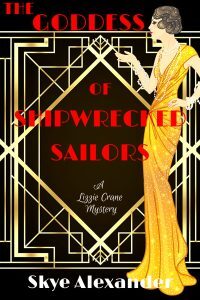
December 1925: Salem, Massachusetts
When Matthew Gardner, the heir to a shipping fortune, hires New York jazz singer Lizzie Crane and her band to perform during the Christmas holidays, she has high hopes that this prestigious event will foster their career and bring them riches and recognition. She’s also eager to reconnect with a handsome man from one of Boston’s most esteemed families, whom she met at an earlier visit to Massachusetts.
But the evening the musicians arrive in historic Salem to begin their engagement, police discover the body of a man near a tavern owned by Lizzie’s cousin–a cousin she even didn’t know she had until Christmas Eve. In the dead man’s pocket is a cryptic letter addressed to Gardner. To compound her dismay, she also learns that her host plans to marry his daughter to the man Lizzie wants for herself.
Soon Lizzie’s caught in the middle of a high-stakes feud between her cousin and her employer over a mysterious lady. When she digs deeper into their conflict, she discovers its roots are deep and bitter: her cousin’s father crewed on one of Gardner’s grandfather’s ships that sunk during a storm in 1868. As she struggles to piece together the puzzle and find the lady at its center, Lizzie becomes a pawn in each man’s deadly game for money and revenge.
To purchase The Goddess of Shipwrecked Sailors click on the following links: Amazon, Barnes and NobleGuest post from Skye Alexander, Author of The Goddess of Shipwrecked SailorsWhere Do Characters Come From?by Skye AlexanderDo writers create our characters or do our characters find us? Are they the children of our minds or do they exist independent of us, somewhere in the ethers, like spirits searching for host mothers to give them life on earth? When the time is right, when they spot an opportunity, do characters slip into our consciousness and reveal themselves to us? Even after decades of writing, I still don’t know the answers to these questions.
Writers have intense and intimate connections with our characters. For many of us, the characters in our books are every bit as real as the flesh-and-blood people we interact with on a daily basis. We know more about them than we know about our spouses, our siblings, our friends. We think about them even when we’re not actually writing. Our characters talk to us when we’re taking a shower, walking in a park, shopping for groceries, and trying to sleep. They ride along with us when we’re commuting to work. They offer advice on cooking or fashion or how to handle our kids––whether or not we asked for it. They latch onto us and won’t let go. They become our constant companions (and yes, we even have a certain fondness for the bad guys). Being a writer gives us license to have imaginary friends, so if you notice us talking to ourselves, we’re not nuts. We’re simply conversing with our BFFs or testing out a bit of dialogue.
People often ask me where my characters come from. Occasionally, a reader insists he or she is someone I’ve written about in one of my books. I refer you folks to the disclaimer at the beginning of each novel that says something to the effect of: “This is a work of fiction. Except in the case of historic fact, any resemblance to actual persons, living or dead, is purely coincidental.”
That doesn’t mean we writers won’t appropriate a particular tidbit we find intriguing, such as your $3,000 custom-made cowboy boots, or that port-wine birthmark in the shape of New Jersey on your thigh, or your habit of clapping your hands three times and circling widdershins before entering your mother-in-law’s house. Warning: Writers are thieves, so don’t do or tell us anything really cool unless you’re okay with it appearing in print. But no, we don’t usually reproduce the ordinary people we know in our novels––unless we’re trying to reap vengeance, but that’s another story.
Fictional characters want to tell their tales and make their marks in the literary world. Sometimes I give a character a bit part and she pushes her way into a starring role. Writers tend to fall in love with our characters. We don’t want to say goodbye when a book ends, so we write a series. Agatha Christie’s Detective Hercule Poirot starred in thirty-three novels, fifty-nine short stories, and one full-length play. Naturally, the protagonist appears in every book in the series, but often subordinate or even minor characters turn up again and again, especially if the stories occur in a particular place, such as Louise Penny’s fictional town Three Pines.
In my Lizzie Crane mystery series, which is set in the mid-1920s, I invite a few historical figures to play cameos. This gives a period feeling to the novels, adds a splash of color, and in some cases furthers the plot. However, these real-life people are presented in a fictitious manner. The artist Edward Hopper comes to a party in the third book in my series The Goddess of Shipwrecked Sailors (released in September 2023). In the fourth novel (Running in the Shadows), Charles Lindbergh performs a daredevil aerial show. In my books, these famous folks do things they really did––yes, Lindbergh was a barnstorming stunt pilot before he flew across the Atlantic and into history books. But, of course, they never actually met my characters (at least, not to my knowledge).
Characters drive stories, they’re not just along for the ride. If we don’t connect with the characters in a novel, we probably won’t read more than a couple chapters. If we really, really like them, we’ll follow them wherever they go. They take us to places and time periods we might never know about otherwise. They present us with ideas and situations we might never have considered before. They teach us about courage, compassion, patience, strength, humility, tragedy, and triumph. They help us understand ourselves and the people we know better. By sharing their journeys with us, characters in books reveal to us the vastness of the human experience with all its complexity, richness, and magic.
Skye Alexander — Author of The Goddess of Shipwrecked Sailors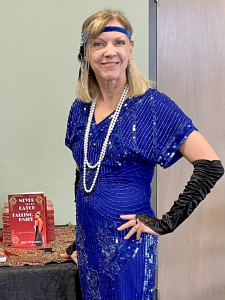 Skye is the author of more than 40 fiction and nonfiction books, many on metaphysical and spiritual subjects.
Skye is the author of more than 40 fiction and nonfiction books, many on metaphysical and spiritual subjects.
Her stories have been published in numerous anthologies internationally, and her work has been translated into more than a dozen languages.
Her Modern Guide to Witchcraft has sold more than 100,000 copies, ranked #10 in magic studies on Amazon, and has over 2,000 positive Amazon reviews.
In August 2021, her new mystery series set in 1925 and featuring jazz singer Lizzie Crane debuted. Skye is also an artist, writing teacher, feng shui practitioner, astrologer, and tarot reader. She divides her time between Texas and Massachusetts.
To learn more about Skye, follow her on her website.Elena Taylor/Elena Hartwell

Header Image by robert mcclurg from Pixabay
The post The Goddess of Shipwrecked Sailors appeared first on The Mystery of Writing.
September 20, 2023
The Vicar: Debut Thriller
The Vicar, debut novel from A.J. Chambers
Author Interview + Book and Author Info + Author Pet Corner!Don’t miss any debut author interviews! Click the link here.The Vicar
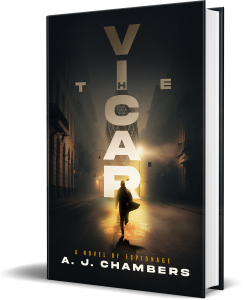
Inspired by the author’s own experience, The Vicar introduces Terry Nolan, an M15 operative who, when he discovers his cover is blown and millions of lives are at stake, will do whatever it takes to stop enemy forces.
Terry Nolan, an off-the-books MI5 operative known as the Vicar, has been officially dead for the past thirty years. But when Nolan is attacked in Boston, it becomes clear his cover is blown. Even worse, his Parishioners—the network of spies who work under the Vicar—have all been compromised.
Nolan races to New York to try and find his last remaining agent, Shae, whom he personally recruited years ago. Instead, he finds Kristen, a young civilian who is determined to save Shae, too—and who may know more than she’s letting on.
In the search for his missing agent, Nolan intercepts intelligence that indicates weapons of mass destruction are on their way to Britain’s four largest cities. Working directly with the ruthless head of MI5, Nolan must call upon all his clandestine skills to save the final Parishioner and find out who is behind the attacks and why. But he’s playing a dangerous game, and the dark secrets of his past are about to catch up with him.
To purchase The Vicar, click the following links: Amazon, Barnes & Noble, BlackStone Publishing.Interview with A.J. Chambers, author of The VicarThe Vicar is inspired by your own experiences working for the British Army. How much is Terry Nolan, the M15 operative and lead character, similar to you?I based Terry on about six individuals that I used to know.
It would be disingenuous for me to say that no part of Terry encompasses a part of me, but isn’t that true of every writer?
When I picture Terry in my mind, the face of a senior NCO who was a friend of mine always appears in my head. He was from the North of England, a great rugby player and a real tough S.O.B.
The one trait that sums up Terry is was a dedication to get the job done, catch the bad guys and protect the innocent victims, whoever they may be. I am not saying the lines aren’t sometimes blurred, but that is to be expected in this type of conflict even though he does his best to stop that from happening.
Terry Nolan is a British operative, but the novel starts in Boston and moves to New York, although Britain features heavily. What drew you to setting The Vicar in the US?I once had the pleasure of meeting Lee Child. Someone posed a similar question to him about his character, Jack Reacher, and I liked his answer. If your readers don’t know, Mr. Child is from the UK. When asked why he didn’t base the character of Reacher there he replied that the UK just wasn’t big enough for the character.
For me it was more a case of history.
For a number of years, individuals from around the world, including the USA, provided money and in some cases weapons, to the Provisional Irish Republican Army, more commonly referred to the PIRA or IRA, as well as other terrorist groups. This isn’t me making things up—it is historical fact.
I also wanted to make The Vicar more international, which gives Terry more room to do his thing. Also, I have lived in America for over thirty years and it just felt natural to include my adopted country in the novel.
Tell us about Shae and Kristen, two important characters in The Vicar.
Given Terry’s personal history, and the events that happened in his past, I wanted to play on his savior complex and the conflict this causes when it comes to him fulfilling his mission.
This need he has to protect and save the two ladies morphs into more of a father/daughter relationship with one of them by the end of the book.
While you base The Vicar in your own experiences, how much did you find yourself exaggerating events for dramatic effect? What kinds of events did you fictionalize?To keep the momentum of the book flowing, things occur much quicker than they would in real life. A perfect example of this in book form is Six Days of the Condor by James Grady. Intelligence gathering can be slow and grueling, also frustrating at times.
While not getting into specific events, some are as they might happen in real life circumstances while others are exaggerated for dramatic effect.
At times Terry does break the rules but this is done to maintain the pace of the book and amp up the urgency of the situation. Remember, Nolan is not a police officer, he is an off the books Intelligence Operative operating in a foreign country.
As a writer I wanted to avoid dragging the reader into days or weeks of interrogation which would result in the pace of the book becoming bogged down.
After leaving the British Army, you became a chef. That’s a big career change! What do you love about cooking, and what’s your specialty?I have always loved cooking. As a child I used to help my mother and father cook, and if not actively helping, I watched what they were doing. Although growing up working class with limited means, which precluded eating out at restaurants ever, my father had spent a number of years in India with the Royal Air Force, before being disabled out due to a slight case of polio, and was a dab hand at making curries. Every couple of weeks he would spend hours in the kitchen making his take on Indian food. It was a joy to watch as well as to eat.
After I left the army I worked with a language school teaching English to older students from Europe for a summer. The class I taught was mainly made up of college age Italians and once or twice a week I used to take great pleasure in cooking for them as they took the time to teach me Italian as well as how to cook their cuisine. After they returned to Italy at the end of the summer one of them contacted me and asked if I would be interested in coming to Italy and doing a culinary apprenticeship, the very next day my bags were packed and I was on my way.
After two years I moved to the United States, where I attended University and studied literature and history. After I left, I went right back to being a chef. Although I have never worked in an Italian restaurant, I found myself specializing in Creole and Caribbean fusion.
The one thing I love about Caribbean food is how fresh and vibrant everything is. I particularly enjoy making fresh seafood such as conch fritters with a spicy mango dipping sauce of seafood ceviche. I like to add a twist to that by adding a passion fruit vinaigrette. Another one of my favorite dishes to make and to eat, especially in the spring or fall is a Cuban meal called Ropa Vieja, which translates to old clothes.
Don’t let the name fool you! It is a wonderfully flavorful dish made with slow cooked flank steak which is shredded, hence the name, and tomatoes with a sofrito base. It is most commonly served with fried sweet plantains, black beans and rice.
What are you working on now?I’m finishing up the sequel to The Vicar, called The Inquisitor. After that, I’ll give Terry a little R&R as I really put him through the wringer in The Inquisitor.
I’m also working on a detective thriller set in Washington, DC. The main character, Xavier Blaque, is an ex-NFL linebacker who, after being forced to retire due to injury, joins DC’s Metropolitan Police Department and is now their lead homicide detective. I should be finished by the fall.
After this I think Terry will have had enough rest and recuperation. We don’t want him getting rusty, do we? so I will begin his third book in the series which will be set shortly before the Russian invasion of Ukraine.
Words of Wisdom for Aspiring Writers:
I guess my advice, after going through the publishing process and all the ups and downs that entails, is to keep the faith—both in yourself and the process. Invest in a really good freelance editor! Mine has been in the business for over forty years and has edited some of the biggest names in the business. He also seems to know everyone, which can be a great help.
Also, when it comes to securing an agent, put yourself out there. If at all possible, attend writers’ conferences such as ThrillerFest and sign up to take part in pitch sessions with agents and publishers. Think about it this way—they are there looking for talent and you will have an opportunity to sit down with them face to face and pitch your novel. Before you do, I’d make a point of having a finished manuscript, one that is as polished as much as possible. Imagine how many unsolicited queries they receive via email on a daily basis. Pitch sessions are definitely preferable and a chance to get noticed.
Lastly, just because you have finished a manuscript don’t fall into the trap of thinking publishers will be beating down the door as if you are the next Hemingway. The Vicar was the third novel I finished writing before it was picked up, thank you Blackstone Publishing.
Even though I was assured by my editor and my agent I was talented, at times it is easy to become despondent. Keep writing, hone your skills and eventually you will get there. Even the most talented writers, singers, athletes etc. practice their chosen field incessantly so they can become great at what they do. So keep at it.
Author Pet Corner Cats: Aurora and Amelia, Shadow wears the hat. Icey is in the glasses, Lulu is upside down.
Cats: Aurora and Amelia, Shadow wears the hat. Icey is in the glasses, Lulu is upside down.Such cute doggos and cats! Thank you for sharing their pictures with us
A.J. Chambers
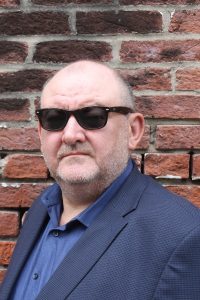 A. J. Chambers was born and raised in the north of England.
A. J. Chambers was born and raised in the north of England.
He joined the British Army in the 1980s and was primarily based in Northern Ireland.
He was also stationed in various countries around the world. After leaving the military, he worked as a chef for over twenty years.
The Vicar is his debut novel.
To learn more about A.J. follow him on Twitter.Elena Taylor/Elena Hartwell
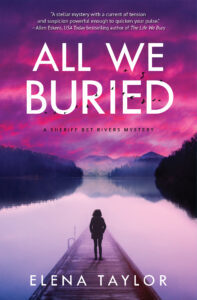
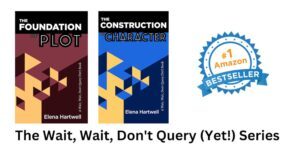
All We Buried, available now in print, e-book, and audio.
Silver Falchion Award Finalist, Best Investigator
Foreword INDIE Award Finalist, Best Mystery
Header Image by Tim Ball from Pixabay
The post The Vicar: Debut Thriller appeared first on The Mystery of Writing.
September 19, 2023
Ghost Tamer, a Paranormal Debut
Ghost Tamer the paranormal debut by Meredith R Lyons
Author Interview + Book & Author Info + Author Pet Corner!Don’t miss any author interviews. Click the link here.Ghost Tamer
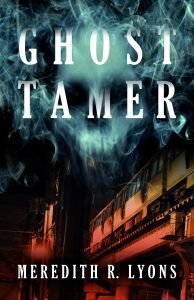
Sarcastic, aspiring-comedian Raely is the sole survivor of a disastrous train wreck. While faced with the intense grief of losing her best friend, she acquires a stalker… that no one else sees. For a ghostly tag-along, Casper’s not so bad. He might even be the partner Raely needs to fight the evil spirit hell-bent on destroying her.
Raely and her transparent friend must learn who this demonic spirit is, why he’s after Raely, and what she has to do to stop him before he destroys her life—and potentially her soul. Which, much to her chagrin, means she’s going to need the help of a psychic, and she’s going to have to rid herself of the pesky ghost hunter who’s interested in exploiting her new abilities.
To purchase Ghost Tamer, click on any of the following links: CamCat Books, Amazon, Barnes & Noble, Books A Million, Bookshop, Kobo, Audible.Interview with Meredith R. Lyons Ghost Tamer features aspiring-comedian Raely. What would you like readers to know about her?
Like a lot of comedians, Raely has trauma in her life that she sometimes works through with humor, but it’s failing her after this recent accident where she loses her best friend.
Snark also proves ineffective against ghosts.
While grappling with her best friend’s death, she’s forced to face the fact that her preferred coping mechanism of denial won’t help her survive this time.
Ghost Tamer is considered paranormal/speculative fiction. What do those genres mean to you?I had a tough time picking a genre for this book. I was so happy when marketing eventually did it for me.
To me, paranormal means existing adjacent to the real world, like ghosts and spirits. Speculative fiction explores the possibilities of what could be. Could there not be ghosts? And if there were, what would that look like?
Ghost Tamer is set in Chicago. You grew up in the New Orleans area, lived in Chicago, and now live in Nashville. What made you set your debut in Chicago rather than somewhere else you’re familiar with?I had a nightmare that I was riding the el train with a friend, coming back from an improv class, and the train flew off the rails. I had nothing new to write at the time, so I wrote the nightmare, thinking it might end up a short story.
We know how that ended.
But as the story started on the el train, Chicago was the only natural location. I never considered putting it anywhere else.
You have a background in acting. How did your theater experience impact the writing of your debut novel?I think it’s given me an elevated sense of dialogue.
I met my audio book narrator when I was at ThrillerFest in New York and when she found out I was an actor, she said it made sense because my dialogue flowed.
I often start a scene with dialogue and fill in everything else later. I like to write with character first, then throw the characters into situations, which makes sense, as acting is the embodiment of a character. I also used my personal experience in the theatre scene in Chicago to color Raely’s experience as an aspiring comedian.
What would you like people to ask about Ghost Tamer ?I’ve been waiting for someone to ask about the theme of forgiveness in Ghost Tamer and whether or not I believe everyone deserves forgiveness.
I had a huge group beta read for an early draft and this topic was hotly debated. There were those who felt that forgiveness was very powerful and those who felt that not all things should be forgiven.
Among the fifteen or so readers, they were split pretty much down the middle. I agree with both perspectives, but mostly I believe that forgiveness does just as much, if not more, for the person doing the forgiving as the person being forgiven. I also believe that just because you forgive someone, doesn’t necessarily mean you let them into your life again or even that they have to know you’ve forgiven them.
It’s a moving on within oneself and a release of resentment, anger, fear, and other corrosive emotions so that they can no longer stain your inner life.
What are you working on now?I have two different books on submission right now. One to agents (I submitted Ghost Tamer direct to publisher, so I’m still agent-free) and one that I’m submitting direct. I’m also writing a few new things.
Last year I churned out four books, which isn’t possible this year with everything that goes into a release and submissions, but I try to get a little writing done every day. And yes, I do have a sequel idea for Ghost Tamer.
We’ll see what happens with it.
Words of Wisdom for Aspiring Writers:Find a support network because the rejection is everlasting and you never know when a comment is going to hit just so. Cultivate a trusted writer circle for perspective, whether the comment was accurate, merely one person’s opinion, or just plain mean spirited. Stay in there long enough and you’ll collect them all.
And most of all don’t stop writing. It’s okay to take a break, but keep your toe in the water somehow. Do some reading. Either books in your genre or for friends who need an eye.
One of the best pieces of advice a friend told me was to have something to write that isn’t connected to anything that’s currently causing your stress. (Like a work you’re editing or one your on submission with.) It doesn’t matter if it’s so outlandish that it will “never be marketable.” Have something to play with that reminds you of why you started writing in the first place.
Author Pet Corner!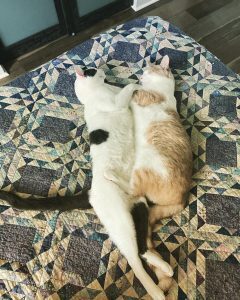 Aang and Cloud!
Aang and Cloud!I have two kitties that often help me write.
Aang is close to thirteen pounds and enjoys riding on my shoulders. When I write, he likes to lay on or near my right arm, preferably on top of the mouse with at least one foot obscuring the keyboard. Aang loves gentle belly rubs and hates thunderstorms.
Cloud is nearly twelve pounds and enjoys cuddling with me only in the wee hours of the morning. I’ll often wake up just before my alarm to find him draped around me. He doesn’t much care about my writing unless I’m trying to have a snack while I work. Cloud enjoys rough scratches and hates loud motors.
We adopted both boys during the pandemic a few months after losing my sixteen year old cat, Jake. They’re now three years old, still inseparable, and enjoy wrestling together, leaping to the top of our kitchen cabinets, and occasional strolls in the backyard on their leashes.
Meredith R. Lyons

Meredith grew up in New Orleans, collecting two degrees from Louisiana State University before running away to Chicago to be an actor.
In between plays, she got her black belt and made martial arts and yoga her full-time day job. She fought in the Chicago Golden Gloves, ran the Chicago Marathon, and competed for team U.S.A. in the savate world championships in Paris. In spite of doing each of these things twice, she couldn’t stay warm and relocated to Nashville.
She owns several swords, but lives a non-violent life, saving all swashbuckling for the page, knitting scarves, gardening, visiting coffee shops, and cuddling with her husband and two panther-sized cats. She’s a member of International Thriller Writers and Sisters in Crime. Her debut novel, Ghost Tamer, comes out September ’23 with CamCat Publishing.
To find out more about Meredith click on any of the following links: Website, Facebook, X (formally Twitter), Goodreads, BookBub, TikTok.Elena Taylor/Elena Hartwell


All We Buried, available now in print, e-book, and audio.
Silver Falchion Award Finalist, Best Investigator
Foreword INDIE Award Finalist, Best Mystery
Header Image by David Mark from Pixabay
The post Ghost Tamer, a Paranormal Debut appeared first on The Mystery of Writing.

